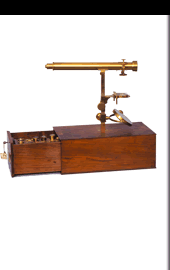Instruments
Iconantidiptic meridian
The name for this instrument, iconantidiptic, is composed by three Greek words, eikón (image), diptikés (double) and antiáo (I go towards).
Amici had described his iconantidiptic telescope, planned for a transit instrument, as early as 1821 in Vol. XIX of the “Memorie di Matematica e di Fisica della Società Italiana delle Scienze”. The idea came back to mind, however, only in August of 1844 when he was in Berlin. While visiting the astronomer Johann Franz Enke (1791-1865), Director of the Berlin Observatory, he saw the Dipleidoscope of Edward John Dent (1790-1853), English chronometer maker. Amici noted that “the meridian of the famous watch maker of London could be more solidly and advantageously constructed with a single isosceles glass prism. The thought of using a glass prism ![]() had also been considered by the illustrious Prussian Astronomer, but since the position which he had planned to give the prism was different from that which I planned, he had already realized, through a simple calculation, that his plan would not have rendered a precise result”.
had also been considered by the illustrious Prussian Astronomer, but since the position which he had planned to give the prism was different from that which I planned, he had already realized, through a simple calculation, that his plan would not have rendered a precise result”.
Amici must have thought through his idea during his trip back to Italy, because he spoke of a “meridian he had invented”as early as September of the same year at the Sixth Meeting of Italian Scientists in Milan. But he published a description of his Iconantidiptic Meridian only eleven years later, in 1855, when asked to describe it by Carlo Matteucci and Raffaele Piria, who printed it in the first issue of the journal “Il Nuovo Cimento”, Vol. I-1855, p. 44-50 (download pdf).
My little instrument, which I call iconantidiptic meridian (table I. fig. 2) is formed by an isosceles triangular glass prism ABCDE with right angle in E. On the side of the right angle it fits into a brass niche of about half of its size and it is firmly fixed there with cement. The jutting base of the niche is fixed with two screws over the oblique section of the metal cylinder GG along which the collar H which supports arm I can rise or descend. A small achromatic telescope L rotates on a horizontal pin attached to this arm.
Since the optical axis of the telescope is next to and parallel with the plane of the large face of the prism, ABCD, a segment of the objective remains covered by the prism opposite. Thus the light coming from any faraway object arrives in two different ways to the objective: a part of it passes directly, and the other passes after having encountered an internal reflection on the large face of the prism. For this reason two images of the object are produced in the telescope, but opposed to each other in such a way that if one image moves from right to left, the other moves from left to right.
So if the reflecting face of the prism is appropriately situated on the plane of the meridian and the telescope is turned towards the sun when it is nearing the time of its passage, two symmetrical images of the sun can be seen. They move towards and go over each other and then move off in separate directions. The moment of the overlapping of the two disks would in this case be true midday, which as you know can be determined with greater precision by taking into account the instants of contact of the edges of the sun when they attach and detach during the observation.
The advantage of Amici’s meridian, Edmondo Marianeschi wrote, is “the precision with which it can take the instant of the passage of the sun at the meridian. [...] At the moment of contact of the two images of the sun there is, at the tangential point, the sudden uniform appearance of a luminous point which is the first ‘germ’ of the lunula of the overlapping” (E. Marianeschi, La meridiana di Giov. Battista Amici (1786-1863), “Coelum”, bimonthly journal for the popularization of astronomy, Bologna, Volume XXXIV, N. 7-8, July-August 1966, pp. 109-113).
